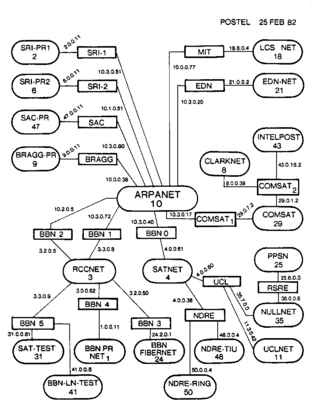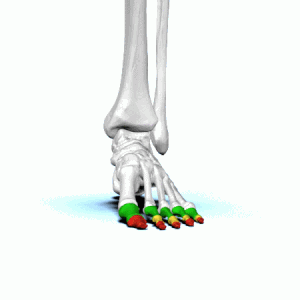In mathematics and computing, the hexadecimal numeral system is a positional numeral system that represents numbers using a radix (base) of sixteen. Unlike the decimal system representing numbers using ten symbols, hexadecimal uses sixteen distinct symbols, most often the symbols "0"–"9" to represent values 0 to 9, and "A"–"F" to represent values from ten to fifteen.
An Internet Protocol address is a numerical label such as 192.0.2.1 that is assigned to a device connected to a computer network that uses the Internet Protocol for communication. IP addresses serve two main functions: network interface identification, and location addressing.

Internet Protocol version 4 (IPv4) is the fourth version of the Internet Protocol (IP). It is one of the core protocols of standards-based internetworking methods in the Internet and other packet-switched networks. IPv4 was the first version deployed for production on SATNET in 1982 and on the ARPANET in January 1983. It is still used to route most Internet traffic today, even with the ongoing deployment of Internet Protocol version 6 (IPv6), its successor.

Internet Protocol version 6 (IPv6) is the most recent version of the Internet Protocol (IP), the communications protocol that provides an identification and location system for computers on networks and routes traffic across the Internet. IPv6 was developed by the Internet Engineering Task Force (IETF) to deal with the long-anticipated problem of IPv4 address exhaustion, and was intended to replace IPv4. In December 1998, IPv6 became a Draft Standard for the IETF, which subsequently ratified it as an Internet Standard on 14 July 2017.
The Internet Protocol (IP) is the network layer communications protocol in the Internet protocol suite for relaying datagrams across network boundaries. Its routing function enables internetworking, and essentially establishes the Internet.
A MAC address is a unique identifier assigned to a network interface controller (NIC) for use as a network address in communications within a network segment. This use is common in most IEEE 802 networking technologies, including Ethernet, Wi-Fi, and Bluetooth. Within the Open Systems Interconnection (OSI) network model, MAC addresses are used in the medium access control protocol sublayer of the data link layer. As typically represented, MAC addresses are recognizable as six groups of two hexadecimal digits, separated by hyphens, colons, or without a separator.
In computer networking, the User Datagram Protocol (UDP) is one of the core communication protocols of the Internet protocol suite used to send messages to other hosts on an Internet Protocol (IP) network. Within an IP network, UDP does not require prior communication to set up communication channels or data paths.
Classless Inter-Domain Routing is a method for allocating IP addresses for IP routing. The Internet Engineering Task Force introduced CIDR in 1993 to replace the previous classful network addressing architecture on the Internet. Its goal was to slow the growth of routing tables on routers across the Internet, and to help slow the rapid exhaustion of IPv4 addresses.
A multicast address is a logical identifier for a group of hosts in a computer network that are available to process datagrams or frames intended to be multicast for a designated network service. Multicast addressing can be used in the link layer, such as Ethernet multicast, and at the internet layer for Internet Protocol Version 4 (IPv4) or Version 6 (IPv6) multicast.
Open Shortest Path First (OSPF) is a routing protocol for Internet Protocol (IP) networks. It uses a link state routing (LSR) algorithm and falls into the group of interior gateway protocols (IGPs), operating within a single autonomous system (AS).

A subnetwork or subnet is a logical subdivision of an IP network. The practice of dividing a network into two or more networks is called subnetting.

A classful network is an obsolete network addressing architecture used in the Internet from 1981 until the introduction of Classless Inter-Domain Routing (CIDR) in 1993. The method divides the IP address space for Internet Protocol version 4 (IPv4) into five address classes based on the leading four address bits. Classes A, B, and C provide unicast addresses for networks of three different network sizes. Class D is for multicast networking and the class E address range is reserved for future or experimental purposes.
An organizationally unique identifier (OUI) is a 24-bit number that uniquely identifies a vendor, manufacturer, or other organization.
In computer networking, Teredo is a transition technology that gives full IPv6 connectivity for IPv6-capable hosts that are on the IPv4 Internet but have no native connection to an IPv6 network. Unlike similar protocols such as 6to4, it can perform its function even from behind network address translation (NAT) devices such as home routers.
In computer networks, a reverse DNS lookup or reverse DNS resolution (rDNS) is the querying technique of the Domain Name System (DNS) to determine the domain name associated with an IP address – the reverse of the usual "forward" DNS lookup of an IP address from a domain name. The process of reverse resolving of an IP address uses PTR records. rDNS involves searching domain name registry and registrar tables. The reverse DNS database of the Internet is rooted in the .arpa top-level domain.
The octet is a unit of digital information in computing and telecommunications that consists of eight bits. The term is often used when the term byte might be ambiguous, as the byte has historically been used for storage units of a variety of sizes.
The Internet checksum, also called the IPv4 header checksum is a checksum used in version 4 of the Internet Protocol (IPv4) to detect corruption in the header of IPv4 packets. It is carried in the IP packet header, and represents the 16-bit result of summation of the header words.
A Request for Comments (RFC), in the context of Internet governance, is a type of publication from the Internet Engineering Task Force (IETF) and the Internet Society (ISOC), usually describing methods, behaviors, research, or innovations applicable to the working of the Internet and Internet-connected systems.

An Internet Protocol Version 6 address is a numeric label that is used to identify and locate a network interface of a computer or a network node participating in a computer network using IPv6. IP addresses are included in the packet header to indicate the source and the destination of each packet. The IP address of the destination is used to make decisions about routing IP packets to other networks.
An IPv6 packet is the smallest message entity exchanged using Internet Protocol version 6 (IPv6). Packets consist of control information for addressing and routing and a payload of user data. The control information in IPv6 packets is subdivided into a mandatory fixed header and optional extension headers. The payload of an IPv6 packet is typically a datagram or segment of the higher-level transport layer protocol, but may be data for an internet layer or link layer instead.







